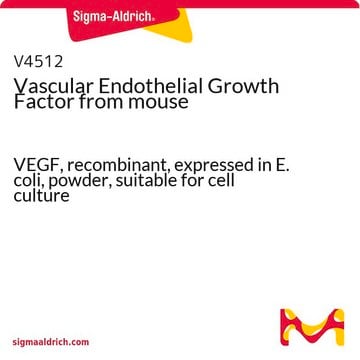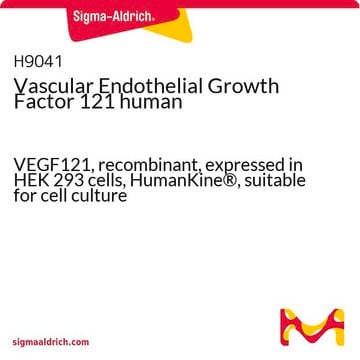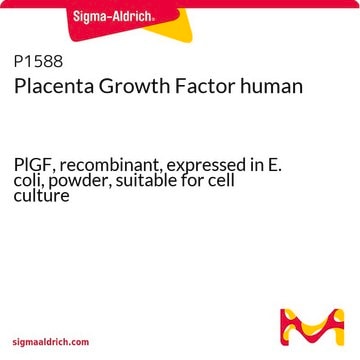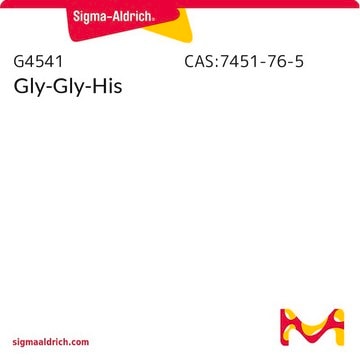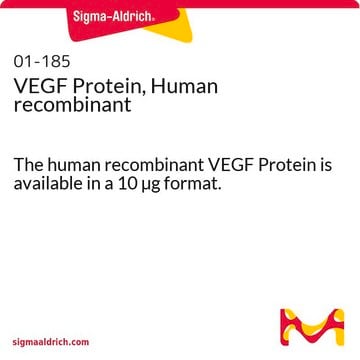추천 제품
제품명
Vascular Endothelial Growth Factor (aa 207-318) human, ≥97% (SDS-PAGE), recombinant, expressed in E. coli, lyophilized powder
생물학적 소스
human
Quality Level
재조합
expressed in E. coli
분석
≥97% (SDS-PAGE)
양식
lyophilized powder
효능
0.75-3.75 ng/mL ED50
분자량
predicted mol wt ~28 kDa
포장
pkg of 5 μg
저장 조건
avoid repeated freeze/thaw cycles
불순물
<1 EU/μg
UniProt 수납 번호
저장 온도
−20°C
유전자 정보
human ... VEGFA(7422)
애플리케이션
Vascular Endothelial Growth Factor (aa 207-318) human also known as VEGF 121 was used for preparing a cellular matrix hybridized with hyaluronic acid (ACM-HA) VEGF constructs which is used in measuring the VEGF-enhanced tissue-engineered bladder graft neovascularization by using dynamic contrast-enhanced MRI. The product was used for creating VEGF-impregnated tissue-engineered construct which was inserted in the critical-sized calvarial defect in the membranous parietal bone of the rabbit for examining and characterizing the angiogenesis necessary for bone formation.
생화학적/생리학적 작용
Potent angiogenesis inducer in vivo.
Vascular Endothelial Growth Factor (aa 207-318) human also referred to as VEGF 121 or Vasculotropin is a basic protein that induces endothelial cell growth, vasculogenesis and angiogenesis. VEGF also enhances the growth of endothelial cells isolated from cerebral cortex, fetal and adult aorta as well as human umbilical vein. Cells enhance VEGF 121 secretion from fibrin implants results in local and controlled blood vessel growth.
기타 정보
112 amino acid residue variant of human VEGF.
물리적 형태
Lyophilized from a 0.2 μm filtered solution in 30% acetronitrile and 0.1% TFA containing 0.25 mg bovine serum albumin.
분석 메모
The biological activity is measured by its ability to stimulate 3H-thymidine incorporation in human umbilical vein endothelial cells.
Storage Class Code
11 - Combustible Solids
WGK
WGK 3
Flash Point (°F)
Not applicable
Flash Point (°C)
Not applicable
개인 보호 장비
Eyeshields, Gloves, type N95 (US)
Sevan Evren et al.
Cells, tissues, organs, 192(4), 250-261 (2010-07-01)
Natural scaffolds have been shown to induce T helper 2 (TH2)-specific immune responses in host tissues; however, the precise mechanisms that underlie this immune response are unknown. Using a porcine animal model, we evaluated the role of Toll-like receptors (TLRs)
Martin Ehrbar et al.
Circulation research, 94(8), 1124-1132 (2004-03-27)
Although vascular endothelial growth factor (VEGF) has been described as a potent angiogenic stimulus, its application in therapy remains difficult: blood vessels formed by exposure to VEGF tend to be malformed and leaky. In nature, the principal form of VEGF
Lisa Cartwright et al.
Journal of biomedical materials research. Part A, 77(2), 390-395 (2006-01-24)
Tissue engineered organs require an immediately perfused vascular tree. Currently, neovascularization assessment requires animal sacrifice and graft harvest. In this pilot study we assess whether neovascularization of an engineered urinary bladder construct is enhanced with vascular-derived endothelial growth factor (VEGF)
Marine Beaumont et al.
NMR in biomedicine, 23(1), 48-55 (2009-08-04)
Tissue engineering is a promising technique for bone repair and can overcome the major drawbacks of conventional autogenous bone grafting. In this in vivo longitudinal study, we proposed a new tissue-engineering paradigm: inserting a biological soft-tissue construct within the bone
Molecular and biological properties of the vascular endothelial growth factor family of proteins.
N Ferrara et al.
Endocrine reviews, 13(1), 18-32 (1992-02-01)
문서
VEGF-A stimulates blood vessel growth via endothelial cell proliferation, migration, and survival during embryonic development.
자사의 과학자팀은 생명 과학, 재료 과학, 화학 합성, 크로마토그래피, 분석 및 기타 많은 영역을 포함한 모든 과학 분야에 경험이 있습니다..
고객지원팀으로 연락바랍니다.
